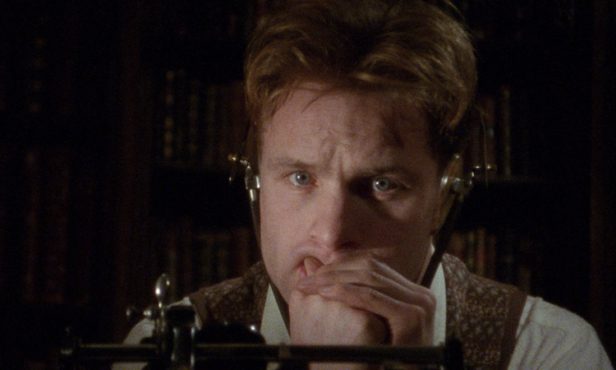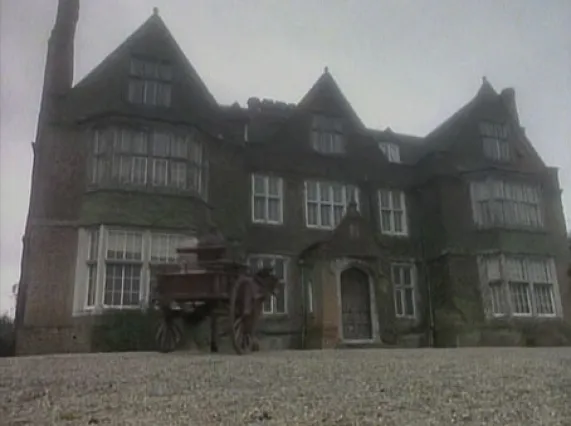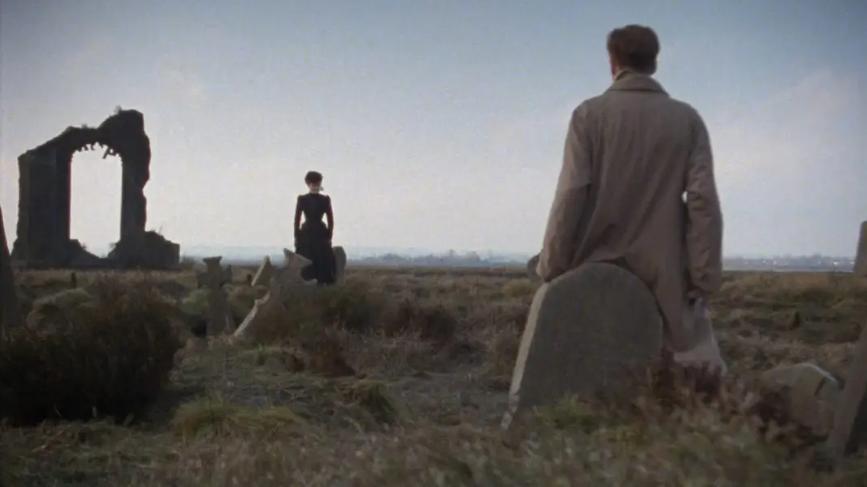I won’t bore you with how my watching Roy Ward Baker’s Quatermass and the Pit led me on a nine-day marathon of Christopher Lee and Peter Cushing movies. Or how this led me onto a bigger jag of gothic stories in general, eventually leading me to Herbert Wise’s 1989 made-for-TV adaptation of Susan Hill’s novel The Woman in Black, adapted for television by Nigel Kneale-who is also the writer for Quatermass and the Pit, itself an adaptation of a BBC series created and written by Kneale.
In other words, it’s a very small serendipitous world, after all.
Suffice it to say The Woman in Black is a gothic ghost story set in the 1920s that left me uneasy and unmoored. Herbert Wise’s gothic tale of a hapless solicitor Arthur Kidd (Adrian Rawlins), evoked a feeling of dread and made my skin crawl.

Kneale’s adaptation, from what I can tell, is largely faithful. Both his and Hill’s story are relatively straightforward. Arthur, a loving family man, has been charged by his boss Mr. Sweetman (David Rydall), to go and sort out the estate of the late Alice Drablow in the small coastal town of Crythin Gifford. Upon arrival, Arthur discovers that the locals give him the cold shoulder whenever he mentions Miss Drablow or Eel Marsh House.
It is a relatively easy assignment. The Drablows have been with the firm for years, and all Arthur has to do is collect Miss Drablow’s papers, organize her things, and have the house ready for sale. Mr. Sweetman, who has been to the Eel Marsh House, is too busy and promises Arthur a promotion, maybe even a partnership, for doing the job.
The way to Eel Marsh House is across a causeway across the marsh, leaving the house cut off from the village, surrounded by water once the tide comes in. A fact that Michael Davis’s camera wallows in. Haunted houses shrouded in fog and mist are a staple of gothic cinema, and The Woman in Black is no different. Yet, Wise and Davis frame the Eel Marsh House not with a stylistic flourish but by shooting it from a distance and a slight angle. They never shoot it straight on, making it appear even more ominous.
It’s not the camera that imbues Eel Marsh House with menace but the reputation we have gleaned from the villagers. Their unease becomes our unease. The simplicity is a hallmark of Wise’s The Woman in Black that, time and time again, makes the movie so effective and nerve-rattling. It is stripped of artifices, leaving only the bare bones of a story passed down from one generation to the next.
On the way to Crythin Gifford, Arthur meets Sam Toovey (Bernard Hampton), a local landowner. Sam notices Drablow’s name on the papers and asks Arthur if he’s attending the funeral. Hearing that he is, Sam smiles, “You’ll be about the only person there is.”

Because it is 1989, because it is a made-for-TV movie, the effects are simple, from the lighting to the almost documentary way Wise and Davis shoot The Woman in Black. Combine this with Kneale’s naturalistic dialogue, and the result is an undercurrent of grounded realism that washes up on the shore on the unnatural elements of the story.
Wise and Davis pepper in little moments of life in the process of happening, as if the camera captured characters unaware. The way we can hear Aruthr’s co-workers talking in the background, but we can’t quite hear everything, just bits of a conversation about the latest Charlie Chaplin movie. Or how Davis’s camera captures the Priest waiting on Arthur, putting the final touches on his frock, making himself presentable. All these little things make the world of The Woman in Black seem fleshed out and grounded.
By doing this, Wise and Kneale can give us glimpses into Arthur’s character. Take the scene where Arthur discovers the phonograph. We see Arthur excitedly put a new wax cylinder on, and make a recording, showing us how making a recording works. Then we see a box of other wax cylinders, Miss Drablow’s recordings, and we begin to get the story of Eel Marsh House.
All of this makes everything so much more nerve-wracking. We can see the Woman in Black; she’s right there. Does no one else see her? Or do they, and are they just pretending not to?
The Woman in Black (Pauline Moran) is first seen by Arthur at Miss Drablow’s funeral. She’s not a figment of CGI or some other special effect. She’s there, she takes up space, and Moran’s face is one of such haunted rage it alone is enough to unnerve the viewer. Every time Arthur sees the Woman in Black, she is closer and closer, another factor in the mounting dread Wise and Kneale conjure.
Wise also utilizes a heightened sound design, the rustling of paper, the crunching of boots on gravel, and the clopping of a horse’s hooves. Out on the marsh, Arthur hears the voices and sounds of a horrible accident, a woman and a child who have lost their way in the marsh and crashed into the ocean. Wise and Davis never show us the accident; we only hear it.
Later, while in the house surrounded by the ocean, Arthur hears footsteps. It is a reminder of the old tale, “The last person on Earth sits alone in his room. There is a knock at the door.” Wise and Kneale take these simple moments and, instead of trying to scare us, merely ask what frightens us. Being alone in the house, in the middle of nowhere, and hearing the sounds of someone else that can’t possibly be there, is terrifying enough on its own. But having the sound come from a room with a door that won’t open is bone-chilling.
Still, it’s nothing compared to hearing a child’s voice say “Hello.” Wise and Davis eschew theatricality and instead strip a ghost story down to the bare basics and, in the process, craft one of the all-time great spine-tinglers.
The other aspect is the likability and wholesomeness of our main character, Rawlins’s Arthur. He’s a genuinely nice guy who doesn’t deserve any of what happens. This out-of-balance mental anguish of the character adds to the creepy factor of The Woman in Black, the sense that none of this is right. An anguish that plays over the canvas of Rawlins’s face magnificently. Rawlins plays Arthur with such a sense of open kindness that lends a true horror to the unfolding events.

Wise and Kneale do a splendid job of teasing out the story behind the Woman in Black and Eel Marsh House while at the same time never giving us the full story. We discover what drives the Woman in Black — a child out of wedlock, adopted by her sister, and a desperate attempt to get her child back. It’s what we don’t find out that haunts us. “When he screams for his mother, who is he screaming for? Which of them?” Nor do we know what turned her from a grieving ghost to a harbinger of doom whose sighting means a child will die.
Rachel Portman’s eerie score is the final touch of this gothic tale of dread. Like everything else in The Woman in Black, it is simple yet effective. It gets under your skin, making your toes curl in anticipation.
The Woman in Black has, at minimum, two jump scares. But these jump scares are not of the ”Boo!” variety. They are a sustained combination of Davis’s framing, Portman’s score, Kneale’s plotting, and Wise’s direction, which makes them not just effective but lasting and memorable, making the scares more potent than a mere jump scare. You can sense Wise and Kneale leading up to these scares, allowing the knowledge to form a knot in your belly from anticipation. One of these scares was shrewdly placed right before a commercial break. Clever bastards.
One article called it ”the most necessary ad break in television history.” I’m forced to concur because I freaked out again watching a Youtube review that showed the jump scare. Wise and Kneale don’t go out of their way to disgust or confound you. Instead, they merely let the Woman in Black and the creepy Eel Marsh House cast their darkly eerie spell.
Unlike most movies, I found the spell that didn’t vanish as the credits rolled. The queasy feeling of unease, like the Woman in Black herself, lingers long after the movie has ended. Many horror movies startle and gross, but Wise’s The Woman in Black haunts not because of what it shows, but because of what it doesn’t show.
Images courtesy of Warner Bros.
Have strong thoughts about this piece you need to share? Or maybe there’s something else on your mind you’re wanting to talk about with fellow Fandomentals? Head on over to our Community server to join in the conversation!

